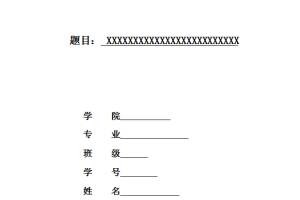摘 要
随着全球知识与经济的不断发展与进步,人们的工作强度越来越大。员工工作压力大,工作倦怠的现象日益突出,员工的工作倦怠问题已经成为了一个长期困扰企业管理者,制约企业生存发展的难题。工作倦怠不仅影响了工作的积极性和工作质量,同时还影响了员工的稳定性和忠诚度,从而为企业发展埋下了极大的隐患。
本文以沈阳人和机械公司为研究对象,首先介绍了企业概况,其次是对基本理论的介绍,然后本文通过问卷调查法和访谈法了解了人和公司员工工作倦怠的原因。发现员工工作倦怠的主要原因有:员工的期望值较高、人岗匹配度低、缺乏民主性的管理、忽视企业文化建设、缺乏有效的激励措施和办公环境差。最后针对这些原因提出了相应的解决措施,具体措施如下:给予员工正确的引导、采用科学化的人员测评方法、让员工参与决策管理、加强企业文化建设、采用多种激励措施和美化办公环境等六个针对性措施。
关键词:工作倦怠;工作压力;工作满意度
Abstract
With the continuous development and progress of the global knowledge and economy, people have more and more working strength. Employees work pressure, job burnout have become increasingly prominent, the problem of job burnout of employees has become a long-term problem in enterprise management, control problem for the survival and development of enterprises. Job burnout not only affects the working enthusiasm and working quality, and also influence on the stability and loyalty of staff, thus laid great dangers for the development of enterprises. Therefore, job burnout problem worthy of our attention, and find out the cause of job burnout and propose specific measures, has very important practical significance.
According to the Shenyang people and machinery company as the research background. Firstly, this paper introduces the outline of enterprise, second is the basic theory is introduced, and then through the questionnaire survey method to understand the causes of burnout and corporate. Found that the main reason for job burnout: employee expectations high, people and post matching degree is low, the lack of democratic management, neglect the enterprise culture construction, the lack of an effective incentive measures and office environment. Finally, the article puts forward the corresponding settlement measures, specific measures are as follows: to give guidance, accurate employee use of personnel evaluation methods, scientific let employee participation in management, strengthen the building of enterprise culture, using a variety of incentives and beautification of the office environment in six specific measures.
Keywords: job Burnout; pressure; job satisfaction
摘 要…………………………………………………………………………………………………………………………. I
Abstract……………………………………………………………………………………………………………………… II
前 言………………………………………………………………………………………………………………………… 1
1 企业简介……………………………………………………………………………………………………………… 2
1.1 企业概况…………………………………………………………………………………………………….. 2
1.2 企业人力资源现状………………………………………………………………………………………. 3
1.3 企业的组织结构………………………………………………………………………………………….. 3
2 员工工作倦怠基本理论………………………………………………………………………………………… 5
2.1 基本概念…………………………………………………………………………………………………….. 5
2.1.1 工作压力……………………………………………………………………………………………. 5
2.1.2 工作倦怠……………………………………………………………………………………………. 5
2.1.3 工作满意度………………………………………………………………………………………… 5
2.2 工作倦怠对组织发展的影响………………………………………………………………………… 6
2.2.1 降低劳动生产率…………………………………………………………………………………. 6
2.2.2 增加人员流动率…………………………………………………………………………………. 6
2.2.3 增加企业运营成本……………………………………………………………………………… 7
3 员工工作倦怠现状调查………………………………………………………………………………………… 8
3.1 调查方案设计……………………………………………………………………………………………… 8
3.2 调查对象分析……………………………………………………………………………………………… 8
3.3 调查结果统计……………………………………………………………………………………………… 9
3.3.1 不同年龄员工的倦怠情况…………………………………………………………………… 9
3.3.2 不同岗位员工的倦怠情况…………………………………………………………………. 10
3.3.3 不同学历员工的倦怠情况…………………………………………………………………. 11
4 员工工作倦怠原因分析………………………………………………………………………………………. 12
4.1 员工的期望值较高…………………………………………………………………………………….. 12
4.2 人岗匹配度低……………………………………………………………………………………………. 12
4.3 缺乏民主性的管理…………………………………………………………………………………….. 13
4.4 忽视企业文化建设…………………………………………………………………………………….. 13
4.5 缺乏有效的激励措施…………………………………………………………………………………. 13
4.6 工作环境差……………………………………………………………………………………………….. 13
5 员工工作倦怠问题的解决方法……………………………………………………………………………. 15
5.1 给予员工正确引导…………………………………………………………………………………….. 15
5.2 采用科学化的人员测评方法………………………………………………………………………. 15
5.3 让员工参与管理决策…………………………………………………………………………………. 15
5.4 加强企业文化建设…………………………………………………………………………………….. 16
5.5 采用多种激励措施…………………………………………………………………………………….. 17
5.6 美化办公环境……………………………………………………………………………………………. 17
结 论………………………………………………………………………………………………………………………. 18
致 谢………………………………………………………………………………………………………………………. 19
参考文献…………………………………………………………………………………………………………………. 20
Appendix………………………………………………………………………………………………………………….. 21
附 录………………………………………………………………………………………………………………………. 26
附 件………………………………………………………………………………………………………………………. 30





